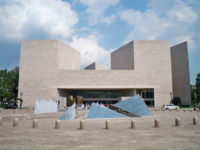There is a Latin expression, Finis origine pendet, which translates roughly to, “The end depends on the beginning.” It would seem especially appropriate for I. M. Pei.
At a recent event honoring Pei at Harvard’s Graduate School of Design, which he attended from 1942 to 1946, his long-time professional partner Harry Cobb told a resonant story. It seems that when Pei was finishing his degree, he proposed a thesis topic to Walter Gropius, the legendary founder of the Bauhaus, who had taken over the Harvard program in 1937. The thesis was for a museum in a garden to be located in Shanghai, drawing on Pei’s knowledge of traditional Chinese landscape design.
According to Cobb, Gropius would have none of it, saying that tradition had no place at the GSD, which was about “changing the world” by discarding history and starting anew. Pei persisted, and Gropius relented—but he told Pei that he would have to “prove” to him the merit of his case.
When the young student finished his thesis, it attracted so much attention that it was published in Progressive Architecture magazine, and Gropius was humble enough to write a warm endorsement to accompany the drawings.
After that, Pei continued to do things others thought he should not. Instead of joining an architecture firm after graduation from Harvard, he worked for William Zeckendorf, a New York real estate developer, who was considered below the respect of the architectural establishment. Pei later persuaded the citizens of Boulder, Colorado, to let him build a research laboratory in the foothills of the Rocky Mountains (one of RECORD’s top 125 buildings) that opponents said should have been off limits to construction. And he horrified the French with a glass pyramid at the Louvre, only to have it embraced as a landmark that now competes with the Eiffel Tower as an icon of Paris.
More recently, Pei designed a museum in Japan that required changing the restrictions on a nature preserve, and still another in his boyhood hometown in China that forced the local authorities to let him violate the local design codes. His Museum of Islamic Art in Doha, completed in 2008, embodied Islamic traditions that could not have been further from his own experience as a Chinese-American.
No one would describe Pei as a revolutionary. But he has consistently gone against the received wisdom—and he has been proved right in almost every case.
On his 100th birthday, Pei may not yet have reached his finis, but he has never abandoned the origine of independence that he showed in defying Walter Gropius.






















Post a comment to this article
Report Abusive Comment